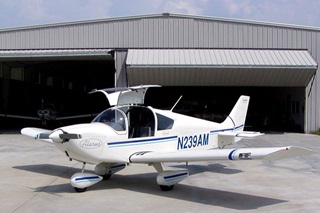
The Aircraft Spotlight feature looks at an airplane type and evaluates it across six areas of particular interest to flying clubs and their members: Operating Cost, Maintenance, Insurability, Training, Cross-Country, and Fun Factor.
If your club is looking for a rugged little low-wing trainer that is relatively new, the certified production Alarus CH2000 might be exactly what you’re looking for. At first glance, it’s easily confused with a Grumman Tiger, but the gull-wing doors and Hershey Bar wings let you know it’s definitely something different. The Great Plains Aero Club (GPAC), based at Augusta Municipal Airport (3AU) in Wichita, Kansas, uses one for its primary training. Club President Curtis Mead shares his club’s experience with the Alarus.
 Operating Cost (5 stars)
Operating Cost (5 stars)
One of the main reasons a club might consider the Alarus are the reasonable operating costs. It has a 115-hp O-235 engine that burns about 4.5 to 5 gph and has a 2,400-hour TBO. Great Plains charges $75 an hour, Hobbs time, wet.
The plane was designed by Chris Heinz, who is best known for his Zenith homebuilts, however, this is a certified production aircraft. It looks like a cross between a Grumman and a Cherokee. “It’s got the Cherokee wings, and a Tiger nose cone and nose gear configuration,” Curtis said. “She’s a pretty small airplane overall.”
The Alarus debuted in the mid-90s and when it first came out, the aircraft were produced by Zenith as the CH2000. “Zenith made it for a little bit and then Alarus bought it out,” Curtis said. Production stopped in 2011. While it’s a less common aircraft, an Internet search found a handful for sale between $30,000 and $60,000.
Maintenance (3 stars)
One advantage of the Alarus is that it is a new design, so it likely will have less wear and tear than similar aircraft. Although production stopped in 2011, Zenair is still supplying parts. “They’re actually really inexpensive to maintain,” Curtis said. “It’s pretty easy to find parts.” It’s O-235 is a common engine, so that shouldn’t present any problems for a mechanic. However, anytime you have a less common aircraft there may be things that mechanics aren’t familiar with, which could increase time or cost of maintenance.
Insurability (4 stars)
GPAC didn’t have any trouble getting insurance for the Alarus. However, since it is a newer aircraft with a higher hull value than it’s other aircraft, it is the most expensive airplane to insure in its fleet. While Great Plains has its Alarus insured for a hull value of about $70,000, “you could probably pick one up cheaper with the way the market has been,” Curtis said.
Training (5 stars)
“The good thing about the Alarus is that it’s truly a great trainer,” Curtis said. “It’s a rugged little airplane, it’s hard to get in trouble in.”
It has small Hershey Bar wings, with a very forgiving airfoil, and a large rudder. “It has a lot of rudder authority. It’s one thing that makes it a nice trainer,” Curtis said.
It also has slat flaps. “It’s almost like a Stuka bomber when you’re coming in,” Curtis said. “With those flaps hanging out there, you have to keep a quite a bit of power in to get a reasonable rate of descent, which is good for a student I think. It’s got great stall characteristics, very benign stall. That’s one thing that makes it such a great trainer.”
The one unique flight characteristic is that it doesn’t like forward slips, but there is a placard to remind pilots not to do them. Besides using it for primary training, GPAC also uses it as an IFR trainer because it has good avionics including a Garmin 430.
 Cross-Country Travel (3 stars)
Cross-Country Travel (3 stars)
With a cruise speed of 99 knots at 75 percent power and a range of just under 500 miles with fuel capacity of 28 gallons, it probably won’t be your first choice for a cross county aircraft. However, the 46-inch wide cabin is “a lot roomier than a 152. It’s as wide as a Bonanza in the cockpit,” Curtis said. “It’s a comfortable airplane to fly in, it’s just not very fast.”
It does offer a modern avionics package including a Garmin 430 that is IFR-certified, so it has more than most trainers and GPAC has used the plane for some longer cross country flights.
Fun Factor (3 stars)
The airplane is light on the controls, in part because it has pushrods instead of cables, but “it’s not snappy in performance,” Curtis said. The visibility is good, but you sit a little deeper than in a 172. The Alarus is easy to fly but at the end of the day, this airplane isn’t designed to be a sports car. It’s more of a Ford—not too flashy but reliable. It was designed to be a rugged, reliable trainer, and that’s what you’ll get.
Overall (4 stars)
The Alarus is an affordable, solid trainer. “They are real stable airplanes. They’re pretty bullet proof, and easy to maintain,” Curtis said. “If I was to equate it to something, I would equate it to a Ford Focus or a Ford Taurus. It’s a good vehicle, it’s a good airplane. It’s not real snazzy, it’s not the fanciest on the inside, but a good airplane.”